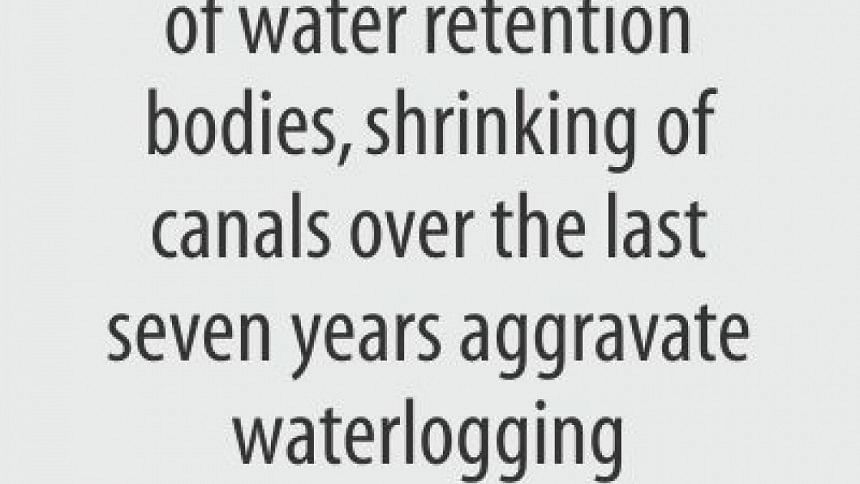The curse of Agrabad

Some locals now keep boats, not cars, in their garages.
Before going out to work, people here always check the tide schedules. During the high tide, businesses come to a grinding halt while students attend classes sitting on high benches as the ground floors of schools go under knee-deep water.
The residents have to readjust their daily life keeping that obvious phenomenon in mind.
This is Agrabad, the port city's oldest residential area, established by Chattogram Development Authority in the early 1960s as an abode for the affluent.
All of its 28 roads reel under water during the high tide as water swells in the Bay twice a day and is injected into the locality by the Karnaphuli River through Mohesh Khal (canal).
Agrabad and its adjacent areas experience waist-deep water and even more due to higher tidal surge at least 12 days a month, centring the full moon and new moon, locals say.
The high tide is more damaging in the rainy season with water cascading down the hills.
“It is only the winter when we get temporary relief,” a frustrated Monsur Ali, a resident of the area, told The Daily Star.
Thanks to gradual disappearance of vast water retention bodies and shrinking of canals, the high tide has been causing waterlogging in the area over the last seven years.
The town planners foresaw none of this while establishing the residential area covering over 82 acres of land, said a CDA official, citing the layout plan of 1959.
During a visit to the area around noon on September 25, one of these reporters came across people wading through water to get to their destinations and students returning from schools negotiating knee-deep water.
Sharmin Hosain, a teacher at a private school in the residential area, said, “I live on Road 17 and it was made higher than some other roads in the area. Yet it goes under water during the high tide.
“Students are dropping out of our school. Because, in the monsoon, the roads sometimes go under about four foot water and parents do not send their children to school fearing that the kids might get drowned.”

The school often has to reschedule the classes as per the tide chart, she added.
But for Anawar Sadat, headmaster of Al Nahian Government Primary School, rescheduling of classes is not allowed.
“Every time the tidal water comes from the Karnaphuli through the Mahesh Khal, students have to sit on the high benches. We cannot reschedule the class time as it is a government school,” he said.
Once a bustling hub, which consists of 1,000 plots and accommodates more than one lakh people, it is now increasingly becoming a neighbourhood of low-income group with the owners leaving the apartments to caretakers or renting their floors at cheap prices.
Abdullah, a vegetable vendor on Road 25, said his landlord has left his one-storey building and rented a house in another neighbourhood.
“Now I stay in his house as caretaker and I do not have to pay rent,” he said, grinning.
Mudin Uddin, a garment worker at the CEPZ, said, “I'm living in a three-bedroom flat and I pay Tk 7,000 a month. It would have cost Tk 20,000 in other residential areas of the port city.”

Visiting the tax office in the area, it was seen that they have kept a boat on the ground floor.
“We had to buy the boat as the water usually reaches the knee during the monsoon and sometimes up to the chest. Without a boat, movement gets very difficult,” said Sarowar Hossain, deputy commissioner, tax zone-4, Chattogram.
Besides, at least 10 locals have been found to own boats for personal use.
The Chattogram Port Authority built a temporary dam on Mohesh Khal in October 2015 to protect Agrabad and North Halishahar, another affected area.
The Tk 2.5 crore dam brought momentary relief to Agrabad and North Halishahar, but it was dismantled after 21 months following uproar from people living in some other places around it.
The reason is simple -- the tidal water obstructed by the dam made its way into new areas. Besides, the pocket, through which water used to be flushed out, was not big enough for this.
There are 17 active canals that flow through the port city into the Karnaphuli. And during the high tide, Chaktai Khal, Rajakhali Khal and Marium Bibi Khal put commercially important areas like Chaktai, Chawkbazar, Asadganj and Khatunganj under ankle-to-waist-

Town planners say filling up of wetlands is the key reason of the waterlogging.
"Water retention areas disappeared over the years causing the tidal surge overflow in residential areas," Shahenul Islam Khan, chief town planner of the CDA, told The Daily Star.
He also acknowledged that tidal surge started to penetrate new areas including Mohra, Chandgao, Chaktai, greater Bakolia, Halishahor, Chawkbazar, Dewanbazar, Khatungonj and Boxirhat two years back with the water retention areas vanishing.
GOVT INITIATIVE
To alleviate the public sufferings caused by waterlogging, the government approved two mega projects worth TK 8,000 crore in August in 2016.
The CDA signed an MoU with Bangladesh Army for the project titled “Canal re-excavation, expansion, renovation and improvement of waterlogging in Chattogram city”.
The Tk 55 billion work is in progress since April last year under 34 Engineering Construction Brigade of Bangladesh Army, who started with re-excavation of 16 canals deemed vital for the port city.
The project, scheduled to be completed by April 2020, includes re-excavation of 36 out of 57 recorded canals in the port city to ensure smooth water flow.
“If we can evict illegal structures from both banks of these canals, re-excavate and renovate the water bodies, three-fourths of the waterlogging can be solved,” Abdus Salam, CDA chairman, told The Daily Star.
Under the project, at least 42 silt traps (that deposits sand rolling down the hills during monsoon) would be built, all the bridges and culverts heightened and water reservoirs created to contain the rain water.
“Besides, 1,000 kilometres of road drain will be built and the existing drains will be re-excavated,” said the top CDA official.
He said the other project worth Tk 2,500 crore is earmarked for constructing an eight-and-a-half-kilometre road-cum-dam from the Chaktai canal's mouth to Kalurghat.
This too is scheduled to end by 2020.
“There are 12 canals along the stretch, and 12 sluice gates will be installed at the mouths of those canals to stave off the tidal surge. I hope those sluice gates will partly rid the port city of the tidal water,” said the CDA boss.
He also hoped that once the whole work is completed, the port city would be largely free from the water-related sufferings.


 For all latest news, follow The Daily Star's Google News channel.
For all latest news, follow The Daily Star's Google News channel. 








Comments